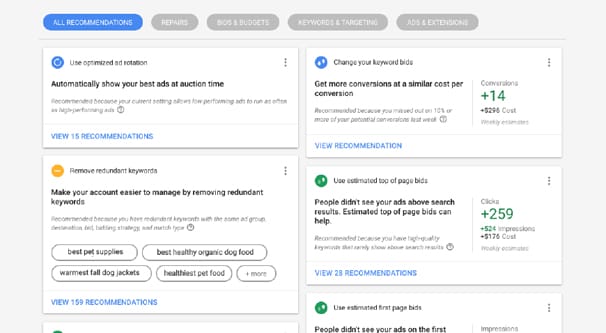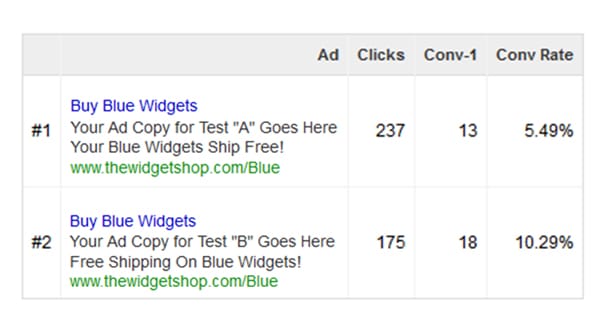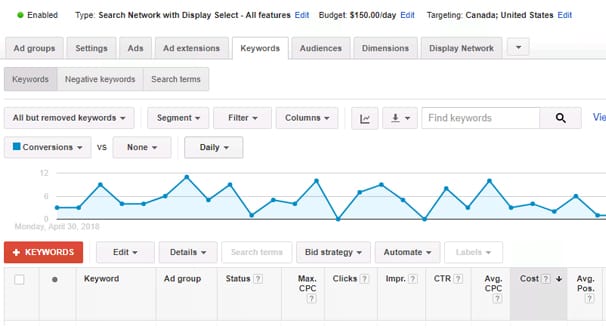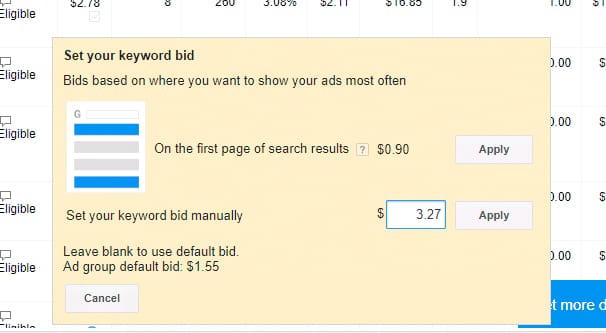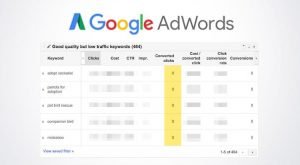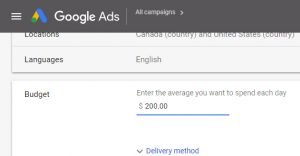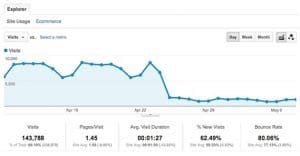Why Did My AdWords Conversions Suddenly Drop?
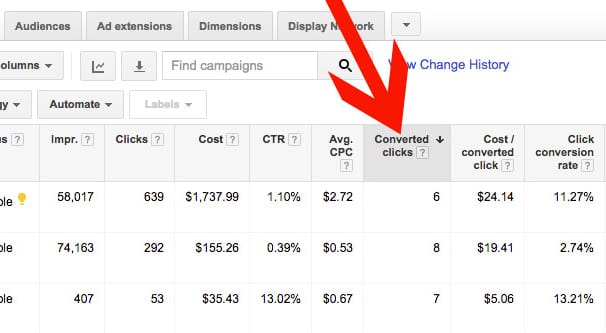
There are a few reasons why your AdWords conversions suddenly drop to nothing, or near nothing. Almost all of those reasons have to do with budgetary considerations. Before I get into that, though, there’s one cause we need to discuss.
Changes You Made
The primary focus of this post is on causes of a conversion drop that aren’t immediately preceded by a change you made to your ads in some way. If you made changes and saw a drop in conversions, well, it’s pretty darn easy to identify the problem, isn’t it?
Look at it this way. Even if data tells you that changing from A to B means you should get an increase in conversions, if you then actually make the change from A to B and see your conversions drop, it’s pretty clear that your change made conversions drop.
Now, it might not be the change from A to B that caused it, but some other related change you made at the same time. Changing your targeting from A to B might mean you’re focused on a better audience, but if you changed your ad copy at the same time, maybe that new copy doesn’t resonate with the new audience as well. Or vice versa; maybe you didn’t change the copy, and the old copy doesn’t work as well with the new audience.
This is part of the problem with split testing, particularly split testing audience targeting. If you test Ad Copy A and Ad Copy B on Audience 1, and you test Ad Copy A on Audience 2, you have an incomplete split test. You might discover that Audience 2 converts better than Audience 1, and you might discover that Ad Copy B works better than Ad Copy A. So you switch to Ad Copy B and Audience 2, but that’s not a result you tested. You might discover that A works better than B with 2, but you didn’t discover that until after the fact because your split testing didn’t cover all the bases.
This is why, when you test different elements, you need to make sure you test each variation and combination of elements. It’s also why we generally recommend that you only test one element at a time; the more elements you test at once, the harder it is to discern which element changing has which impact. Sure, you can run six split tests at once, but the more tests you run, the more variations you need to run at once, at an exponential curve. Even if you have a bot-based system to automate those iterations in all their variety, you still need the budget to run all of those tests. Even at $5 each, if you have 81 different variations you need to test, your budget gets huge very quickly.
In any case, this is all a digression. If you make a change and your conversions drop, revert the change and they should come back. If you make a change and conversions drop, and you revert the change and they don’t come back, well, you might have other issues.
More importantly, if you don’t make a change and you see an abrupt drop in conversions, something may have happened externally that caused it. That’s what I’m trying to help you diagnose today.
External Causes of Dropped Conversions
There are two ways conversions can drop; slowly and gradually, and abruptly or shaprly.
Slow and gradual drops in conversions are fairly natural. Over time, your ads lose their effectiveness. Ad saturation leads to ad blindness, and your audience may eventually become saturated themselves. If you’ve managed to sell to everyone in your target audience, no amount of changing your ad is going to get those people to buy again, at least for a lot of one-time sale products. Think of how often you need to buy a toaster or a washing machine. Barring damage or equipment failure, you’re not going to get repeat customers very often, at least not outside of the B2B case.
Constant testing, iteration, and improvement helps to keep your ads fresh and new and, most importantly, interesting. When your ads become boring, users stop caring about them, and they stop converting. With a large enough audience, though, this won’t happen rapidly.
No, the issue we’re concerned about today is abrupt, sharp declines in your conversions. Something that happens overnight or over the span of two or three days is characterized as abrupt, when marketing trends are measured in weeks or months or years.
So what might happen to cause an abrupt drop in conversions without you making a change to cause it? There are a few options.
- New competition hits the market.
- Old competition becomes fierce.
- Scheduling you forgot about ends.
- Seasonality rears its head.
- Your budget runs out.
- Google makes a change to their system.
Let’s look at each of these in detail.
A New Challenger Approaches
As time goes on, it becomes easier and easier to start a new business. Globalization has led to the proliferation of easy contact between suppliers and manufacturers with the people who have new ideas. Shows like Shark Tank showcase how easy it is to turn an idea, even a bad idea, into something that Exists, even if it doesn’t perform well. On top of that, the expanse of easy tools you can use for cheap or free to “growth hack” a new startup means a business can go from concept to actively selling a product in as little as a month or two. Experienced entrepreneurs can build their system and create, market, grow, and sell half a dozen new businesses every year.
This means that a lot of markets that are not traditionally agile need to become agile. Think back a decade; how often did a mattress company need to change things up? You needed a mattress, so you went to one of the dozen mattress companies. They didn’t need to make new products, they had their slate of offerings, and you had to choose.
Now, in addition to all of those old offerings, you have existing companies bringing new products to the market. Everything from variations on the Sleep Number automatic adjustable beds to various mixes of spring and foam, all the way to those new companies like Leesa and Casper, who will mail you a box full of dense foam that unrolls and inflates into a full size mattress with a huge money-back guarantee.
Now suddenly companies offering traditional mattresses from stores like Sleep Doctor or Sears need to worry, not just about their old existing competition making new products, but about new mail-order companies springing up out of nowhere. They can’t see a new storefront being built, because a mattress can ship from a manufacturer’s warehouse without a retail facility ever existing.
Meanwhile, that company’s advertising is suddenly hit. They see a dramatic drop in conversions because this new company has hit the market with their product, targeting all of these existing keywords, and they have a fresh, unrefined budget to throw at the problem. These new companies want to invest heavily in their first wave of sales, so they dominate search results and PPC lists by using venture capital to fund high-volume, high-positioned ads.
It’s the age-old problem of supply and demand. There are, say, 10 available ad slots throughout the day. There are a lot more, of course, but for this thought exercise we’ll consider ten. There are 12 companies competing for those 10 slots, which means 2 of them are left out of rotation. Generally it’s slots number 7, 8, 9, and 10 that have shifting and churn, as companies jostle their bids up and down a few cents to get their positioning. The companies at the top are usually bidding high enough they aren’t dunked down.
Then these new companies come in. Not only is there a new player, they have money to burn. They crank up their bids nice and high, dominate position 1, and bump everyone else down. Now, of course, in PPC and AdWords there’s not really as big a drop between 1 and 2 as there is in organic search. There’s still a drop, though, and if this newcomer dominates their niche hard enough, it can be difficult to compete. New competition simply steps over and outpaces the old established brands.
Now, if this new company succeeds, they’ll eventually have to dial back their spending and settle into a new normal. The older brand can adapt and compete again, though it might be troublesome for a few months or even years. Still, abrupt new competition can definitely cause an abrupt drop in conversions from ads that don’t have the ability to adapt.
Old Competition Levels Up
I mentioned this one in passing already, but the same sort of niche domination or takeover can happen when an older competitor decides they want to compete on a new front. Maybe you’re used to stiff competition at the enterprise level, but your enterprise competitor introduces a new small business plan, which drives a lot of customers from your market to theirs. It’s the same effect, only with a more refined base to start.
This is actually often better for the established brand being outrun, because it’s easier to compete with someone who knows what they’re doing. An older company expanding into a new niche is, nevertheless, likely to only outspend their competition by a small amount to attempt to take over a niche. A newcomer with money to burn is harder to fight, at least until they burn out.
Your Time Ran Out
I’m only going to gloss over this one because it’s a pretty simple error and it’s extremely easy to correct. Often times, when you’re setting up ads, you set a schedule for them to run. It might be centered around a holiday or a sale, or just focused on historically high-converting months, but it exists.
It’s easy to just monitor your ads from day to day, forgetting that one day they are scheduled to end. Then that day comes and you suddenly see a drop in conversions. There’s always going to be that moment of panic before you realize what happened, but thankfully, it’s an easy enough fix.
Of course, talented ad managers don’t let ad coverage slip like this. The start and end dates of new campaigns will have some natural fluctuation, but the standard always-on ads should make the baseline at least an acceptable number of conversions.
Changing Seasons
As a related issue to scheduling, seasonality often has an impact on certain brands. It’s natural for a company selling snow blowers to see an uptick in conversions when the first snowstorms of the year strike, but once the winter is over and the last frost has passed, it’s pretty unlikely that they’ll keep up that level of sales.
If your conversions drop somewhat abruptly, it’s just possible that the seasonality has ended. Of course, generally you should know the good and bad times for your company. This one should never come as a surprise.
The Well Runs Dry
Budgeting concerns are, well, always a concern. If you run out of budget, your ads shut down, and your conversions dry up. After all, you can’t sell through ads if your ads aren’t running.
There are two things you need to monitor about every ad you run, and those are the volume of conversions and the cost per conversion. It’s a great thing to run tests for new keywords with new ads, but you need to keep those two factors in mind. A keyword with a low cost per conversion might not be great if you only get two conversions a month. A keyword with 1,000 conversions a month might nevertheless be a bad keyword if each conversion costs 50x what your usual conversions cost.
Once you’ve been running ads for a while, you will settle on some standard ads and keywords that perform well throughout the year. These are ads you want to have a standard budget, where you put most of your effort so you get a consistent return. It’s worthwhile to make these into their own campaign with its own budget, and then run your other tests in other campaigns with smaller, segregated budgets. This way, you’ll never run into an issue where a test gets out of hand and eats up your full budget for your standard ads.
The World Changes Around You
A final note here is that, sometimes, Google makes a change to the way AdWords works. When the system changes, sometimes you’re caught in a new filter or one of your existing techniques is no longer valid. If you can’t figure out why your ads have stopped converting, it can be worthwhile to take a look at any changes or updates Google may have made to their system on that date. Unfortunately, all you can do in these circumstances is adapt to the new normal.

 ContentPowered.com
ContentPowered.com
